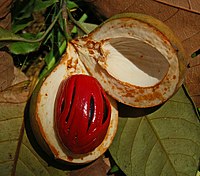
Photo from wikipedia
Tissue culture of hazelnut (Corylus avellana L.) represented the promising strategy for production of its valuable compound, paclitaxel, but one of the most important problems is initial callus browning in… Click to show full abstract
Tissue culture of hazelnut (Corylus avellana L.) represented the promising strategy for production of its valuable compound, paclitaxel, but one of the most important problems is initial callus browning in its callus culture. To obtain healthy callus cells of C. avellana, three different culture media, Murashige and Skoog (MS), Nas and Read (NRM), and Driver and Koniuki (DKW), in combination with 500 mg dm-3 citric acid, 500 mg dm-3 acetic acid, and 500 mg dm-3 polyvinylpyrrolidone (PVP) were applied. These cultures were passed two sub-cultures in the same media. Also, a novel modified sub-culture system was designed and compared to routine techniques. The sub-culture system was changed as following: the induced calli were transferred to a liquid media with the same composition and after developing the cell suspension, the cells were immobilized on a solid medium. In the first experiment, it was demonstrated that the medium compositions had an effect on the growth rate and callus browning reduction although they could not eliminate the browning. The results have shown that the highest growth indices were related to NRM with 500 mg dm-3 acetic acid + 500 mg dm-3 citric acid and to NRM with 500 mg dm-3 PVP in the first culture. These media had the least amount of browning (9.15 %). In the two next sub-cultures, NRM without additives had the maximum growth rate and the lowest browning was observed on the same media as in the first subculture (13.3 %). The technique of modified sub-cultures increases growth rate ten times in comparison with routine cultivation method.
Journal Title: Biologia Plantarum
Year Published: 2020
Link to full text (if available)
Share on Social Media: Sign Up to like & get
recommendations!